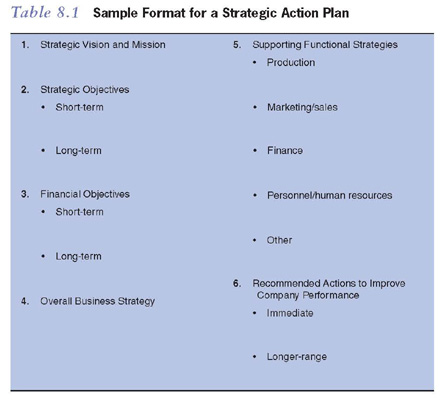
(See related pages)
The lessons of this chapter are that (1) some strategic options are better suited to certain specific industry and competitive environments than others and (2) some strategic options are better suited to certain specific company situations than others. Crafting a strategy tightly matched to a company's situation thus involves being alert to which strategy alternatives are likely to work well and which alternatives are unlikely to work well. Specifically:
1. What basic type of industry environment (emerging, rapid-growth, mature/slow growth, stagnant/declining, high-velocity/turbulent, fragmented) does the company operate in? What strategic options and strategic postures are usually best suited to this generic type of environment?
2. What position does the firm have in the industry (leader, runner-up, or weak/distressed)? Given this position, which strategic options merit strong consideration and which options should definitely be ruled out?
In addition, creating a tight strategy-situation fit entails considering all the external and internal situational factors discussed in Chapters 3 and 4 and then revising the list of strategy options accordingly to take account of competitive conditions, industry driving forces, the expected moves of rivals, and the company's own competitive strengths and weaknesses. Listing the pros and cons of the candidate strategies is nearly always a helpful step. In weeding out the least attractive strategic alternatives and weighing the pros and cons of the most attractive ones, the answers to four questions often help point to the best course of action:
1. What kind of competitive edge can the company realistically achieve, given its resource strengths, competencies, and competitive capabilities? Is the company in a position to lead industry change and set the rules by which rivals must compete?
2. Which strategy alternative best addresses all the issues and problems the firm confronts.
3. Are any rivals particularly vulnerable and, if so, what sort of an offensive will it take to capitalize on these vulnerabilities? Will rivals counterattack? What can be done to blunt their efforts?
4. Are any defensive actions needed to protect against rivals' likely moves or other external threats to the company's future profitability?
In picking and choosing among the menu of strategic options, there are four pitfalls to avoid:
1. Designing an overly ambitious strategic plan—one that overtaxes the company's resources and capabilities.
2. Selecting a strategy that represents a radical departure from or abandonment of the cornerstones of the company's prior success—a radical strategy change need not be rejected automatically, but it should be pursued only after careful risk assessment.
3. Choosing a strategy that goes against the grain of the organization's culture.
4. Being unwilling to commit wholeheartedly to one of the five competitive strategies—picking and choosing features of the different strategies usually produces so many compromises between low cost, best cost, differentiation, and focusing that the company fails to achieve any kind of advantage and ends up stuck in the middle.
Table 8.1 provides a generic format for outlining a strategic action plan for a single business enterprise. It contains all of the pieces of a comprehensive strategic action plan that we discussed at various places in these first eight chapters.
